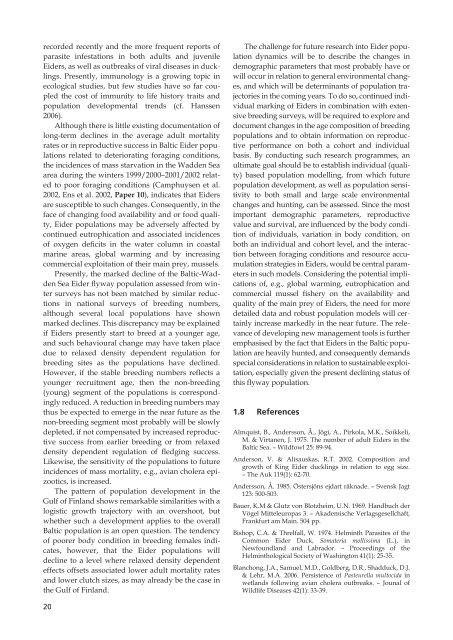Factors affecting population size of Baltic Common Eiders Somateria ...
Factors affecting population size of Baltic Common Eiders Somateria ...
Factors affecting population size of Baltic Common Eiders Somateria ...
Create successful ePaper yourself
Turn your PDF publications into a flip-book with our unique Google optimized e-Paper software.
ecorded recently and the more frequent reports <strong>of</strong><br />
parasite infestations in both adults and juvenile<br />
<strong>Eiders</strong>, as well as outbreaks <strong>of</strong> viral diseases in ducklings.<br />
Presently, immunology is a growing topic in<br />
ecological studies, but few studies have so far coupled<br />
the cost <strong>of</strong> immunity to life history traits and<br />
<strong>population</strong> developmental trends (cf. Hanssen<br />
2006).<br />
Although there is little existing documentation <strong>of</strong><br />
long-term declines in the average adult mortality<br />
rates or in reproductive success in <strong>Baltic</strong> Eider <strong>population</strong>s<br />
related to deteriorating foraging conditions,<br />
the incidences <strong>of</strong> mass starvation in the Wadden Sea<br />
area during the winters 1999/2000–2001/2002 related<br />
to poor foraging conditions (Camphuysen et al.<br />
2002, Ens et al. 2002, Paper 10), indicates that <strong>Eiders</strong><br />
are susceptible to such changes. Consequently, in the<br />
face <strong>of</strong> changing food availability and or food quality,<br />
Eider <strong>population</strong>s may be adversely affected by<br />
continued eutrophication and associated incidences<br />
<strong>of</strong> oxygen deficits in the water column in coastal<br />
marine areas, global warming and by increasing<br />
commercial exploitation <strong>of</strong> their main prey, mussels.<br />
Presently, the marked decline <strong>of</strong> the <strong>Baltic</strong>-Wadden<br />
Sea Eider flyway <strong>population</strong> assessed from winter<br />
surveys has not been matched by similar reductions<br />
in national surveys <strong>of</strong> breeding numbers,<br />
although several local <strong>population</strong>s have shown<br />
marked declines. This discrepancy may be explained<br />
if <strong>Eiders</strong> presently start to breed at a younger age,<br />
and such behavioural change may have taken place<br />
due to relaxed density dependent regulation for<br />
breeding sites as the <strong>population</strong>s have declined.<br />
However, if the stable breeding numbers reflects a<br />
younger recruitment age, then the non-breeding<br />
(young) segment <strong>of</strong> the <strong>population</strong>s is correspondingly<br />
reduced. A reduction in breeding numbers may<br />
thus be expected to emerge in the near future as the<br />
non-breeding segment most probably will be slowly<br />
depleted, if not compensated by increased reproductive<br />
success from earlier breeding or from relaxed<br />
density dependent regulation <strong>of</strong> fledging success.<br />
Likewise, the sensitivity <strong>of</strong> the <strong>population</strong>s to future<br />
incidences <strong>of</strong> mass mortality, e.g., avian cholera epizootics,<br />
is increased.<br />
The pattern <strong>of</strong> <strong>population</strong> development in the<br />
Gulf <strong>of</strong> Finland shows remarkable similarities with a<br />
logistic growth trajectory with an overshoot, but<br />
whether such a development applies to the overall<br />
<strong>Baltic</strong> <strong>population</strong> is an open question. The tendency<br />
<strong>of</strong> poorer body condition in breeding females indicates,<br />
however, that the Eider <strong>population</strong>s will<br />
decline to a level where relaxed density dependent<br />
effects <strong>of</strong>fsets associated lower adult mortality rates<br />
and lower clutch <strong>size</strong>s, as may already be the case in<br />
the Gulf <strong>of</strong> Finland.<br />
20<br />
The challenge for future research into Eider <strong>population</strong><br />
dynamics will be to describe the changes in<br />
demographic parameters that most probably have or<br />
will occur in relation to general environmental changes,<br />
and which will be determinants <strong>of</strong> <strong>population</strong> trajectories<br />
in the coming years. To do so, continued individual<br />
marking <strong>of</strong> <strong>Eiders</strong> in combination with extensive<br />
breeding surveys, will be required to explore and<br />
document changes in the age composition <strong>of</strong> breeding<br />
<strong>population</strong>s and to obtain information on reproductive<br />
performance on both a cohort and individual<br />
basis. By conducting such research programmes, an<br />
ultimate goal should be to establish individual (quality)<br />
based <strong>population</strong> modelling, from which future<br />
<strong>population</strong> development, as well as <strong>population</strong> sensitivity<br />
to both small and large scale environmental<br />
changes and hunting, can be assessed. Since the most<br />
important demographic parameters, reproductive<br />
value and survival, are influenced by the body condition<br />
<strong>of</strong> individuals, variation in body condition, on<br />
both an individual and cohort level, and the interaction<br />
between foraging conditions and resource accumulation<br />
strategies in <strong>Eiders</strong>, would be central parameters<br />
in such models. Considering the potential implications<br />
<strong>of</strong>, e.g., global warming, eutrophication and<br />
commercial mussel fishery on the availability and<br />
quality <strong>of</strong> the main prey <strong>of</strong> <strong>Eiders</strong>, the need for more<br />
detailed data and robust <strong>population</strong> models will certainly<br />
increase markedly in the near future. The relevance<br />
<strong>of</strong> developing new management tools is further<br />
emphasised by the fact that <strong>Eiders</strong> in the <strong>Baltic</strong> <strong>population</strong><br />
are heavily hunted, and consequently demands<br />
special considerations in relation to sustainable exploitation,<br />
especially given the present declining status <strong>of</strong><br />
this flyway <strong>population</strong>.<br />
1.8 References<br />
Almquist, B., Andersson, Å., Jõgi, A., Pirkola, M.K., Soikkeli,<br />
M. & Virtanen, J. 1975. The number <strong>of</strong> adult <strong>Eiders</strong> in the<br />
<strong>Baltic</strong> Sea. – Wildfowl 25: 89-94.<br />
Anderson, V. & Alisauskas, R.T. 2002. Composition and<br />
growth <strong>of</strong> King Eider ducklings in relation to egg <strong>size</strong>.<br />
– The Auk 119(1): 62-70.<br />
Andersson, Å. 1985. Östersjöns ejdart räknade. – Svensk Jagt<br />
123: 500-503.<br />
Bauer, K.M & Glutz von Blotzheim, U.N. 1969. Handbuch der<br />
Vögel Mitteleuropas 3. – Akademische Verlagsgesellchaft,<br />
Frankfurt am Main. 504 pp.<br />
Bishop, C.A. & Threlfall, W. 1974. Helminth Parasites <strong>of</strong> the<br />
<strong>Common</strong> Eider Duck, <strong>Somateria</strong> mollissima (L.), in<br />
Newfoundland and Labrador. – Proceedings <strong>of</strong> the<br />
Helminthological Society <strong>of</strong> Washington 41(1): 25-35.<br />
Blanchong, J.A., Samuel, M.D., Goldberg, D.R., Shadduck, D.J.<br />
& Lehr, M.A. 2006. Persistence <strong>of</strong> Pasteurella multocida in<br />
wetlands following avian cholera outbreaks. – Jounal <strong>of</strong><br />
Wildlife Diseases 42(1): 33-39.

















